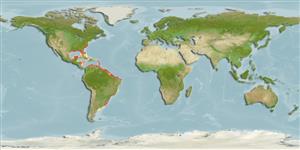Teleostei (teleosts) >
Eupercaria/misc (Various families in series Eupercaria) >
Sciaenidae (Drums or croakers)
Etymology: Menticirrhus: Latin, mentum = beard, chin + Latin, cirrus = curly.
More on author: Linnaeus.
Environment: milieu / climate zone / depth range / distribution range
Ecology
Marine; brackish; demersal; oceanodromous (Ref. 51243); depth range ? - 40 m (Ref. 9626). Subtropical; 43°N - 42°S, 98°W - 34°W
Western Atlantic: Cape Cod in Massachussets, USA to northern Argentina.
Length at first maturity / Size / Weight / Age
Maturity: Lm 17.7, range 16 - ? cm
Max length : 50.0 cm TL male/unsexed; (Ref. 9626); common length : 30.0 cm TL male/unsexed; (Ref. 3702); max. published weight: 1.1 kg (Ref. 40637)
Inhabits coastal waters, usually over sandy-mud to hard sand bottoms. Common along beaches. Juveniles occur usually in water of lower salinity.
Chao, L.N., 1978. Sciaenidae. In W. Fischer (ed.) FAO species identification sheets for fishery purposes. West Atlantic (Fishing Area 31). Volume 4. FAO, Rome. (Ref. 3702)
IUCN Red List Status (Ref. 130435)
Threat to humans
Harmless
Human uses
Fisheries: commercial; gamefish: yes
Tools
Special reports
Download XML
Internet sources
Estimates based on models
Preferred temperature (Ref.
123201): 14.8 - 27.9, mean 24.4 °C (based on 552 cells).
Phylogenetic diversity index (Ref.
82804): PD
50 = 0.5020 [Uniqueness, from 0.5 = low to 2.0 = high].
Bayesian length-weight: a=0.00794 (0.00734 - 0.00860), b=3.08 (3.06 - 3.10), in cm total length, based on LWR estimates for this species (Ref.
93245).
Trophic level (Ref.
69278): 3.5 ±0.0 se; based on diet studies.
Resilience (Ref.
120179): Medium, minimum population doubling time 1.4 - 4.4 years (tm=2; tmax=4; Fec=28,691 (batch fecundity)).
Fishing Vulnerability (Ref.
59153): Moderate vulnerability (38 of 100).
Nutrients (Ref.
124155): Calcium = 78.1 [44.9, 148.7] mg/100g; Iron = 0.951 [0.511, 1.649] mg/100g; Protein = 21.2 [19.2, 23.5] %; Omega3 = 0.326 [0.192, 0.520] g/100g; Selenium = 22 [12, 41] μg/100g; VitaminA = 11.7 [4.4, 35.5] μg/100g; Zinc = 0.867 [0.647, 1.267] mg/100g (wet weight); based on
nutrient studies.
